|
|
|
Sort Order |
|
|
|
Items / Page
|
|
|
|
|
|
|
| Srl | Item |
| 1 |
ID:
137560


|
|
|
|
|
| Summary/Abstract |
This paper deals with an untypical military officer, Kisbarnaki Farkas Ferenc (or Farkas Ferenc de genere Kisbarnaki), who also had a good relationship with the Roman Catholic Church and scouting movement. His career evolved smoothly until 1944. The Wehrmacht occupied the Kingdom of Hungary on 19 March, and not much later the front reached the Hungarian border. A part of the Hungarian leader group—including Governor Horthy—wanted to extricate Hungary from the war and therefore contacted the Soviet leader. But the German secret service knew everything about this negotiation as well. Therefore a coup d’etat was organized by the German secret services using the Hungarian extreme-right parties as well. 15 and 16 October were key days of the coup d’etat. Although some became loyal to the Hungarian Government, a large number of people joined the new regime. A few officers and clerks waited to see whether the coup d’etat would prove successful or not. Kisbarnaki Farkas was an officer of this kind. From then on his fate was linked to the will of the new puppet government. The paper presents how Kisbarnaki Farkas acted in various political situations and what kind of decisions he made during this period. It is also an important question how all this influenced his post-war life.
|
|
|
|
|
|
|
|
|
|
|
|
|
|
|
|
| 2 |
ID:
099837
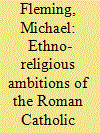

|
|
|
|
|
| Publication |
2010.
|
| Summary/Abstract |
This paper differentiates between centrifugal and centripetal aspects of ethno-nationalism to help account for the ascendancy of communism in the immediate aftermath of World War II in Poland. It argues that the directing of social antipathy to defined out-groups allowed the Polish Workers' Party (PPR) to manage social anger and that the Roman Catholic Church's ethno-religious agenda was aligned with the PPR's ethno-nationalist policy. Furthermore, it is contended that the Church's toleration of hostile actions directed at minority communities supported the PPR's management of social anger. The paper concludes that the Church, despite its manifest intentions and contrary to contemporary perceptions, played a role in the PPR's achievement of hegemony.
|
|
|
|
|
|
|
|
|
|
|
|
|
|
|
|
| 3 |
ID:
139040


|
|
|
|
|
| Summary/Abstract |
The Roman Catholic Church and other religious actors are confronting the nuclear issue with renewed vigor, condemning the nuclear status quo and pressing for more-dramatic steps toward disarmament.
|
|
|
|
|
|
|
|
|
|
|
|
|
|
|
|
| 4 |
ID:
115432
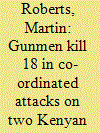

|
|
|
| 5 |
ID:
125213
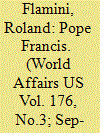

|
|
|
|
|
| Publication |
2013.
|
| Summary/Abstract |
Piled in the storeroom of a leading shoemaker in Rome are several pairs of new, red leather shoes, in different styles and various sizes and half-sizes. Among them are the shoes intended for the new Fisher of Men of the Roman Catholic Church, Pope Francis. But the freshly minted pontiff immediately dispensed with the tradition of wearing red shoes, preferring to keep his sturdy, well-worn black cap toes. He also rejected the ermine-trimmed, elbow-length red cape worn by popes before him, buttoned down the front, and known as a mozzetta; and he kept his own iron pectoral cross in preference to the offered gold one. When the former Cardinal Jorge Mario Bergoglio, lately archbishop of Buenos Aires, appeared for the first time on the balcony of St. Peter's Basilica on a rainy March 13th evening, he wore the white papal cassock and, speaking good Italian, told the huge crowd that the cardinals in the conclave had chosen him "from almost the end of the world."
|
|
|
|
|
|
|
|
|
|
|
|
|
|
|
|
| 6 |
ID:
137304
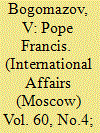

|
|
|
|
|
| Summary/Abstract |
A YEAR AGO, on March 13, 2013, Archbishop of Buenos Aires Cardinal Jorge Mario Bergoglio was elected head of the Roman Catholic Church (RCC) and, therefore, head of the Vatican city-state (officially the Holy See) as Pope Francis. These twelve months were brimming with comments on what had been done and what was expected from the new Pope. The wide range of views and opinions coming from Russia, the U.S., Western Europe, and Latin America stretch from pragmatic and realistic to extremist and radical.
|
|
|
|
|
|
|
|
|
|
|
|
|
|
|
|
| 7 |
ID:
127004


|
|
|
|
|
| Publication |
2013.
|
| Summary/Abstract |
The Scottish independence referendum debate, like the Act of Union of 1707, has significant religious dimensions. The Act gave special recognition through the monarch to the Presbyterian Church of Scotland. The Church, a national church, has not yet declared a position on independence, but is seeking to protect its existing privileges whatever the result. The Roman Catholic Church, recognised by the Scottish Parliament, unlike its formal rejection by the UK Parliament and monarchy, symbolically associates itself with the case for independence. Paradoxically, Catholics supporting independence subject themselves, in their religious lives, to an authoritarian foreign power. The SNP Scottish Government attempts to draw Roman Catholic support for independence from its traditional support base in the Labour Party by cultivating a sense of religious grievance that is not justified by the evidence. Old religious divisions are still relevant but non-religion is growing fast and resulting in new perspectives on the independence debate.
|
|
|
|
|
|
|
|
|
|
|
|
|
|
|
|
| 8 |
ID:
137202
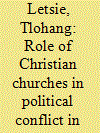

|
|
|
|
|
| Summary/Abstract |
This paper examines the role played by Christian churches in political conflict in Lesotho. It argues that Christianity has played changing roles in the conflict that has characterised Lesotho's politics since 1970. At first, the two largest Christian denominations – the Roman Catholic Church (RCC) and the Lesotho Evangelical Church (LEC) – were associated with the rival Basotho National Party and Basutoland Congress Party (and its offshoots) respectively. The differences between the two denominations trickled down and became a source or intensifier of political conflict. All this happened while the leadership of the two churches worked together, amid high mistrust, within the Christian Council of Lesotho. The political polarity between the ‘Congress’ and the ‘Nationalist’ streams subsided with the splits within the Congress parties and subsequent formation of new parties. On the other hand, mistrust between the leadership of the RCC and the LEC subsided following a change of leadership in the two churches, together with one in the Anglican Church of Lesotho in the first decade of the 21st century. Following these developments, there ceased to be a link between Christian denominations and political conflict in the country. The Christian churches have recently become the most reliable mediators in political conflict.
|
|
|
|
|
|
|
|
|
|
|
|
|
|
|
|
| 9 |
ID:
131862
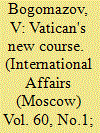

|
|
|
|
|
| Publication |
2014.
|
| Summary/Abstract |
ON MARCH 13, 2013, the conclave of the cardinals of the Roman Catholic Church surprised the world by electing Archbishop of Buenos Aires Jorge Mario Bergoglio as a new Pope. What looked as unexpected and unpredictable is emerging as a deliberate and calculated choice. The cardinals intended to renew and rejuvenate Catholicism, to make it more dynamic and more flexible and, in general, better suited to the globalized world brimming with threats and challenges. The task of this scope and this importance was entrusted to a hierarch who is not young or even middle-aged - he is 76.
|
|
|
|
|
|
|
|
|
|
|
|
|
|
|
|
|
|
|
|
|